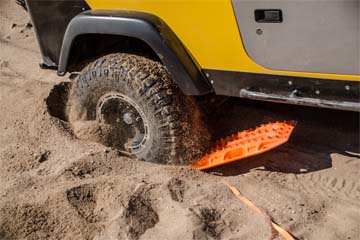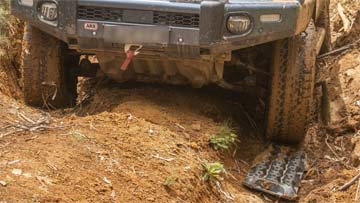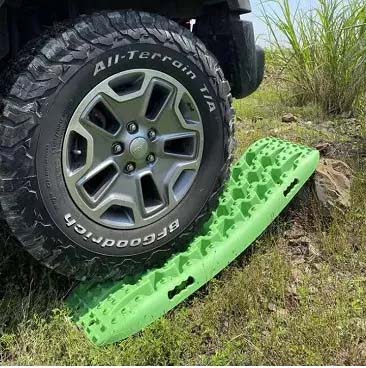About Recovery Traction Boards
I’m sure you've all seen the bright plastic boards strapped onto the roof or side of a 4X4, you may even own a set and this section will give you some ideas on how to use them.
Traction boards, commonly called MaxTrax’s, after the first company to make these modern traction aids, are produced by many companies. Some of these knock-offs are high quality but many are junk that will let you down when you need them most. However, quality products are versatile, ultra-reliable with no moving parts, can be used on any vehicle without modification, and are easy to carry.
Traction boards give you a valuable tool that can be useful in many ways:
• Improved grip on wet rock, mud or snow;
• Provide flotation and help stop the vehicle from sinking into soft ground like sand, snow or mud;
• Traction boards can also provide additional clearance –by raising the tires which in turn raises the entire vehicle not just the body as a typical “lift” does.
• They can be used to help level your vehicle at a camp site
• And they can provide a wide stable base for a high-lift jack
To a greater or lesser extent, each of the three traction environments are found in most terrains and, as with any recovery gear, it's important to understand what you're trying to achieve and to know how to do it before you start. Like any type of recovery boards you need some careful thinking and effort to set the recovery up properly. If you use them correctly they can be effective, but you can’t just arbitrarily throw them near a tire and expect them to work some kind of magic.
Here's a short summary of some tips from some highly experienced overland travelers.
SAND

- Sand.jpg (41.13 KiB) Viewed 1327 times
Dig first, right down in front of and underneath the tire. You need to get the tip of the board down low and just about jam it in under the tire. Also, dig away any sand that's touching the under body. Then using first gear low-range crawl (very slowly) until you're on the boards, then a slight amount of acceleration to get up and away. If you're going to drop tire pressures further (always a good idea), do so after the board is pushed under the tire not before, so the tire expands onto the board. Try and make sure the board is as flat as possible, although I’m told they may work at an angle of up to 40 degrees.
MUD

- Tire in Track.jpg (40.81 KiB) Viewed 1327 times
Use a similar technique as with sand, however, it's often harder to dig in mud. You may have to consider jacking the wheel up and slipping you traction board underneath. In mud you can easily get cross axled and that's where you put a traction board, or two, under the wheel with least weight on it. You may also need to do some track building. Put the board(s) on top, or stack two or more on top of each other, on to ground. Sometimes in mud, you can use the boards to stop the car from sinking in the first place by using them to build a roadway.
Some mud tracks are slicker along one wheel track and the other. You can use your boards to build a “roadway” on one side of the car firming up the slippy side.
SNOW
Basically treat snow like mud, but snow is much easier to dig out, if colder. While I have no direct experience with snow I’m told that one can create snow ruts and lay the boards in them to provide a firm roadway. Boards can also help to support your vehicle in soft snow, just be careful you don't end up getting yourself into more trouble that way. As in any slippery surface your tires may have traction on the board but if the board slides around so will your vehicle.
ROCKS

- bridging rock.jpg (77.83 KiB) Viewed 1327 times
Good quality traction boards can be useful in rocks for clearance and bridging. Here is where the difference between top quality and bargain boards can really show itself. Often, your traction boards will need to be stacked two or more high to get clearance and to take the weight of the vehicle. If used for bridging be sure to put some rocks or logs under the board to help support the vehicle weight. Since it is unlikely that there will be soft ground the risk of the boards moving is high, so think about how that can be avoided. Boards can provide better traction than rocks, particularly when the rocks are wet, so even when there's no clearance problems they can be useful if braced properly.
RUTS
As 35”, 37” and larger tires become more popular wheel ruts become deeper. For extra axle and diff clearance you can use traction boards in the ruts, often stacked two or more high, and supported underneath as required. Then drive over the boards. Again, add track building material if needed. If you do dig, then dig the center of the track out and put the dirt and material in the ruts. This way you're simultaneously lowering the center, to get more axle/diff clearance, and making the ruts shallower, don't dig the outside of the track which just makes it unnecessarily wider.
YOUTUBE
A very good evaluation of various traction board quality was done on YouTube by Ronny Dahl (
https://www.youtube.com/watch?v=SntXKcKKvW8) and is worth a watch.